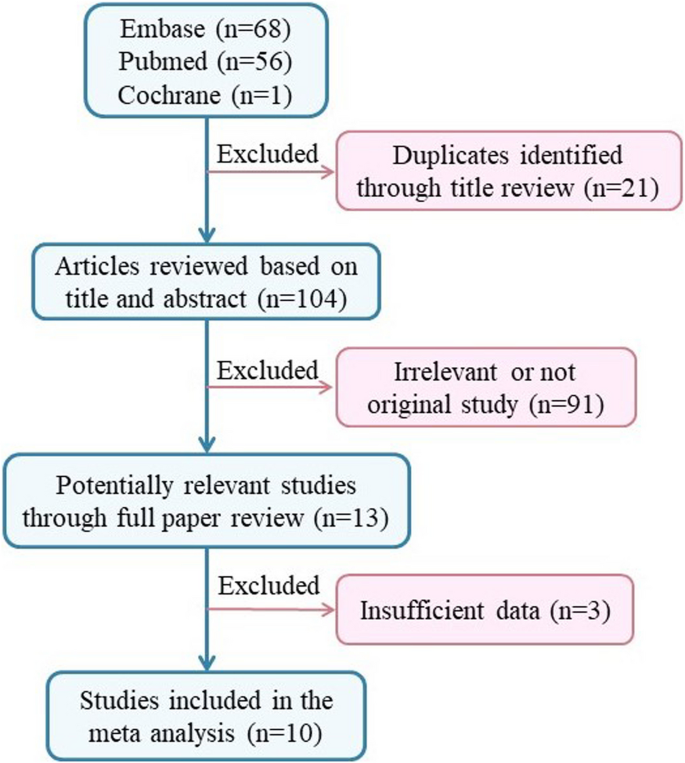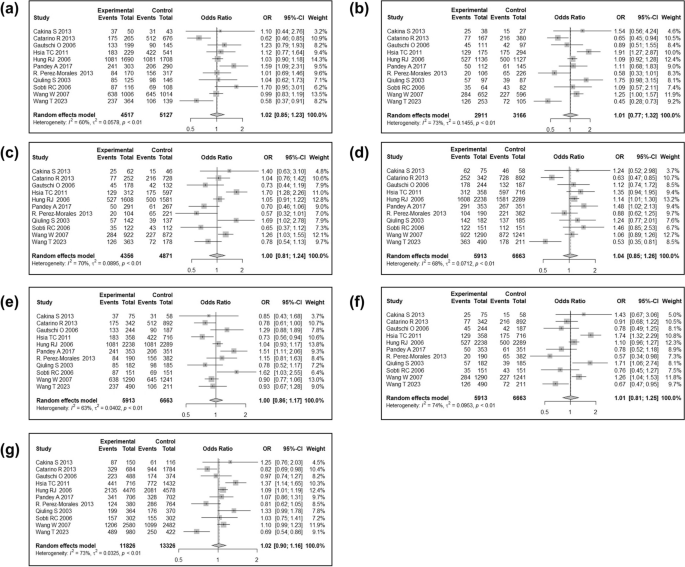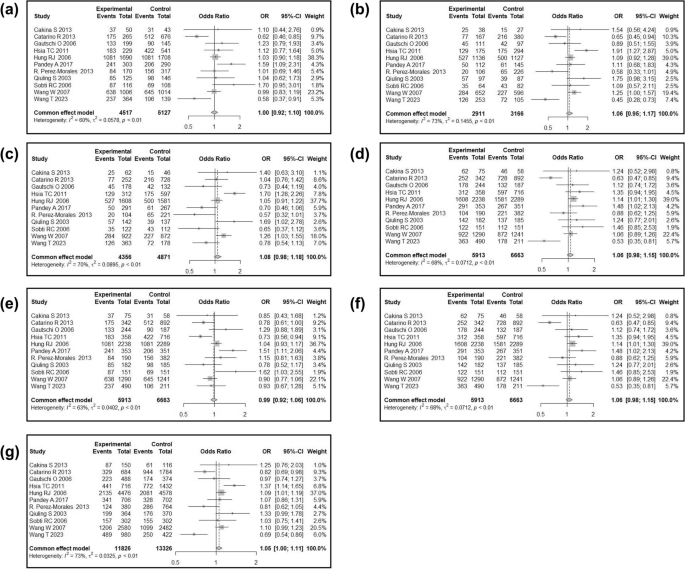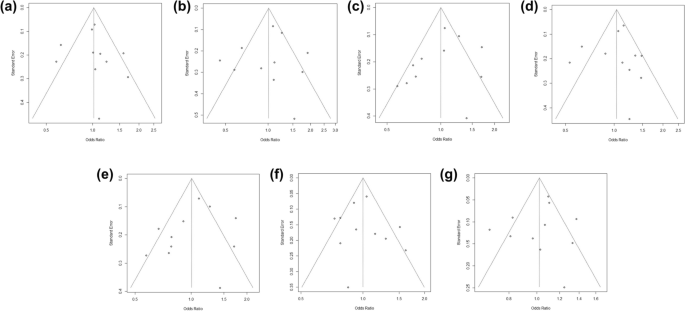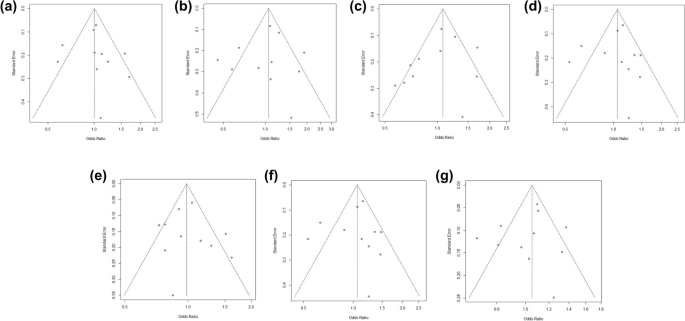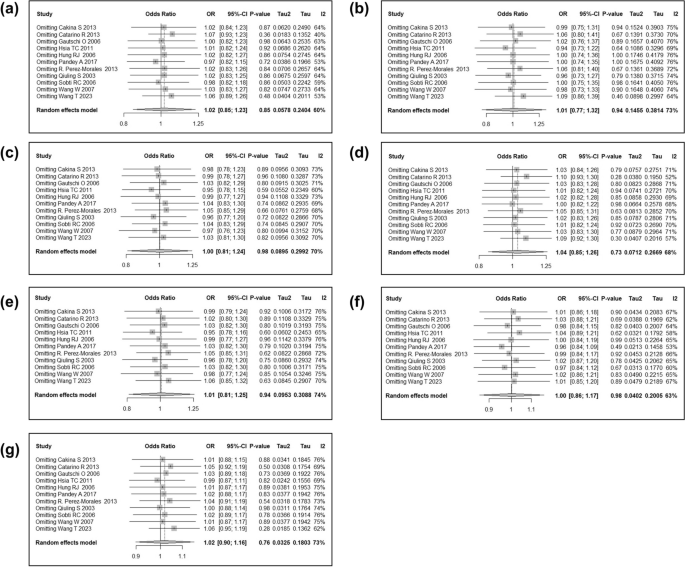- Research
- Open access
- Published:
Association of CCND1 rs9344 polymorphism with lung cancer susceptibility and clinical outcomes: a case-control study
BMC Pulmonary Medicine volume 24, Article number: 167 (2024)
Abstract
Background
Cyclin D1 (CCND1) plays a pivotal role in cancer susceptibility and the platinum-based chemotherapy response. This study aims to assess the relationship between a common polymorphism (rs9344 G > A) in CCND1 gene with cancer susceptibility, platinum-based chemotherapy response, toxicities and prognosis of patients with lung cancer.
Methods
This study involved 498 lung cancer patients and 213 healthy controls. Among them, 467 patients received at least two cycles of platinum-based chemotherapy. Unconditional logistical regression analysis and meta-analysis were performed to evaluate the associations.
Results
The lung adenocarcinoma risk was significantly higher in patients with AA than GG + GA genotype (adjusted OR = 1.755, 95%CI = 1.057–2.912, P = 0.030). CCND1 rs9344 was significantly correlated with platinum-based therapy response in patients receiving PP regimen (additive model: adjusted OR = 1.926, 95%CI = 1.029–3.605, P = 0.040; recessive model: adjusted OR = 11.340, 95%CI = 1.428–90.100, P = 0.022) and in the ADC subgroups (recessive model: adjusted OR = 3.345, 95%CI = 1.276–8.765, P = 0.014). Furthermore, an increased risk of overall toxicity was found in NSCLC patients (additive model: adjusted OR = 1.395, 95%CI = 1.025–1.897, P = 0.034; recessive model: adjusted OR = 1.852, 95%CI = 1.088–3.152, P = 0.023), especially ADC subgroups (additive model: adjusted OR = 1.547, 95%CI = 1.015–2.359, P = 0.043; recessive model: adjusted OR = 2.030, 95%CI = 1.017–4.052, P = 0.045). Additionally, CCND1 rs9344 was associated with an increased risk of gastrointestinal toxicity in non-smokers (recessive model: adjusted OR = 2.620, 95%CI = 1.083–6.336, P = 0.035). Non-significant differences were observed in the 5-year overall survival rate between CCND1 rs9344 genotypes. A meta-analysis of 5432 cases and 6452 control samples did not find a significant association between lung cancer risk and CCND1 rs9344 polymorphism.
Conclusion
This study suggests that in the Chinese population, CCND1 rs9344 could potentially serve as a candidate biomarker for cancer susceptibility and treatment outcomes in specific subgroups of patients.
Background
Lung cancer is a prevalent disease that seriously endangers global public health [1,2,3,4]. According to statistics, there were about 2.20 million newly-diagnosed lung cancer cases and 1.79 million mortalities worldwide every year [4, 5]. Lung cancer accounts for more than 20% of cancer-related deaths worldwide, surpassing the combined mortality rates of prostate, breast, and colon cancers [1, 6,7,8]. Despite the progress made in targeted therapy and immunotherapy in the recent decades, platinum-based chemotherapy remains the most widely used treatment option in clinical practice [9,10,11,12]. However, due to individual variations in sensitivity, only a subset of patients benefits from this treatment [13]. Given the potential toxic reactions, it is urgent to discover reliable predictive biomarkers to predict the prognosis, therapeutic efficacy and toxicity of lung cancer patients, which is crucial for promoting personalized medicine and enhancing therapeutic outcomes [14,15,16].
Cyclins D1 (CCND1) plays a vital role in cell cycle regulation which mediates the G1 to S phase transition [17,18,19]. It also has a fundamental involvement in human cancer progression, including cell proliferation, transcription, chromosome duplication and stability, DNA damage response, metabolism, tumor migration and invasion [17, 20, 21]. Multiple clinical studies demonstrated that dysregulation of CCND1 is associated with poor prognosis and platinum-based chemotherapy response in various human cancers, highlighting its potential as a tumor predictive biomarker [22,23,24,25,26,27,28,29,30,31,32].
Single nucleotide polymorphisms (SNPs) refer to DNA sequence polymorphisms caused by single nucleotide variation at the genomic level, accounting for over 90% of all known polymorphisms [33,34,35]. Cyclins D1 is the second most frequently amplified locus in human solid tumors [36, 37]. The association between CCND1 A870G (rs9344) polymorphism and cancer risk has been previously investigated in lung cancer [38,39,40,41,42,43]. However, due to the limited number of studies and sample size, the exact role of CCND1 polymorphism in predicting lung cancer risk remains unclear. Only few studies have been conducted to investigate the correlation between CCND1 rs9344 and platinum-based chemotherapy response in lung cancer.
This study aimed to investigate the association of CCND1 rs9344 with cancer susceptibility, platinum-based chemotherapy, toxicity and overall survival of patients with lung cancer by performing hospital-based case-control study. Additionally, a meta-analysis was conducted using 5432 cases and 6452 control samples to evaluate the association between CCND1 rs9344 polymorphism and lung cancer risk. The results may provide evidence in support of the potential utilization of CCND1 rs9344 as a predictive biomarker for prognosis and chemotherapy sensitivity in Chinese patients with lung cancer in certain conditions.
Methods
Study design
Setting
During November 2011 to May 2013, 498 patients with primary lung cancer (diagnosed by cytology or histology) were consecutively recruited at Xiangya Hospital and the Affiliated Cancer Hospital of Central South University in Changsha, Hunan Province, China. During the same period, 213 healthy controls were collected from the physical examination center of Xiangya Hospital of Central South University. This study was approved by the Ethics Committee of Xiangya School of Medicine, Central South University (registration number: CTXY-110008-2), and all subjects enrolled have signed the informed consent.
Participants
All patients had been histologically or cytologically confirmed to have primary lung cancer. Subjects who were pregnant, lactating, had active infections, symptomatic brain or leptomeningeal metastases, or other previous or concurrent malignancies were excluded from the study. Among them, 467 patients were enrolled in the platinum-based chemotherapy response study. The inclusion criteria were as follows: (1) They were not administered radiotherapy and/or biological therapy prior to or during chemotherapy; (2) they received at least two cycles of platinum-based chemotherapy; (3) they underwent full follow-up (to March 2017); (4) tumors were assessed before and during treatment using the same imaging methods (Supplementary Table 1). Platinum-based chemotherapy regimens include pemetrexed + platinum (PP), gemcitabine + platinum (GP), paclitaxel + platinum (TP), docetaxel + platinum (DP), etoposide + platinum (EP), and other platinum-based chemotherapy regimens (irinotecan + platinum, navibine + platinum). In the case of the healthy controls, individuals with a smoking history, a history of lung ailments, or those engaged in high-risk occupations such as chemical, construction, asbestos, and coal mining work were excluded.
Variables
The endpoints of the study were as follows: chemotherapy response was evaluated based on the Response Evaluation Criteria in Solid Tumors (RECIST) guidelines and categorized as responders (complete response: CR, partial response: PR) or non-responders (stable disease: SD and progressive disease: PD). Two professional radiologists independently evaluated the CT scans of lung cancer patients before and after chemotherapy to assess the treatment effectiveness after two cycles of therapy. In case of disagreement, a third radiologist was consulted. Toxicity was assessed according to the National Cancer Institute Common Toxicity Criteria 3.0 during the first two cycles of chemotherapy regimen. Grade 3 or 4 toxicity was defined as severe toxicity. Severe gastrointestinal toxicity was grade 3 or 4 nausea and vomiting. Severe hematological toxicity included grade 3 or 4 hypochromia, leukopenia, neutropenia and thrombocytopenia. Patients who experienced any type of the grade 3 or 4 toxicities described above were defined as suffering severe overall toxicity.
For the lung caner patients, age, sex, smoking status, stage, histological type, and chemotherapy regimens were collected. For the healthy controls, age, sex and smoking status were collected. The above factors age, sex, smoking status, stage, histological type, and chemotherapy regimens were considered as covaraites in this study.
DNA extraction and genotyping analysis
Venous blood DNA was extracted using the Genomic DNA Purification Kit (Promega, Madison, WI, USA). CCND1 rs9344 was genotyped using the Sequenom MassARRAY System (Sequenom, San Diego, CA, USA).
Study selection and data extraction criteria of meta-analysis
The Pubmed, Embase and Cochrane databases were utilized to identify original studies examing the association between CCND1 rs9344 and lung cancer susceptibility (up to March 29, 2023). The search formula was: “CCND1 or Cyclin D1” and “genetic polymorphism or polymorphisms or variant or rs9344” and “lung cancer”. Included studies had to be original case-control studies with detailed CCND1 rs9344 genotype frequencies or available data. The qualities of selected studies were independently assessed and identified by two researchers. The following information was extracted from the included studies: the last name of the first author, year of publication, country, ethnicity, cancer type, source of cases and controls, number of cases and controls, genotyping method, genotype or allele frequency, and HWE p values for controls.
Statistical analysis
The study size was estimated using Power Analysis and Sample Size (PASS) 2021 (NCSS, LLC. Kaysville, Utah, USA) at a power value of 0.80. The chi-square test was used to assess differences in proportions between groups for the categorical variables. The median age of lung cancer patients, 57 years old, was used as cut-off value. The Hardy-Weinberg equilibrium was calculated using the chi-square test. Associations between CCND1 rs9344 and cancer susceptibility, therapeutic response and toxicity were estimated by unconditional logistic regression. Factors including age, sex, smoking status, stage, histological type, and chemotherapy regimens were considered as covaraites in this study. Survival curves were calculated using the Kaplan-Meier method, and survival analyses were conducted using Cox proportional hazards regression analysis. All significance tests were two-sided, and P < 0.05 was defined as statistically significant. The above analyses were performed using PLINK 1.9 and PASW statistics v18.0 (IBM Co., Armonk, NY, USA).
In the meta-analysis, the association between cancer risk and CCND1 rs9344 was assessed by calculating pooled OR and 95% CI. The heterogeneity of the effect size across studies was estimated and quantified by Cochrane’s Q test and I2 test. The random effect model is selected if P < 0.1 or I2 > 50%, otherwise, the fixed effect model is adopted. The stability of the results was assessed by sensitivity analysis. The inverted funnel plot was used to estimate the publication bias. All statistical analysis was performed in R4.2.3. P < 0.05 was considered statistically significant.
Results
Participants and descriptive data
In this study, 498 cases of lung cancer (394 males and 104 females) and 213 healthy controls (80 males and 133 females) were included. The clinical characteristics of the participants, including sex, age, histology, tumor stage, regimen, therapeutic response and toxicities were listed in Table 1 and Supplementary Table 1. The genotype distribution of CCND1 rs9344 was in agreement with the Hardy Weinberg equilibrium (P = 0.539).
Association between CCND1 rs9344 and lung cancer susceptibility
After adjusting for age and sex, the association between CCND1 rs9344 polymorphism and cancer risk was analyzed in additive, dominant and recessive models, respectively. The results of logistic regression analysis were shown in Table 2 and Supplementary Tables 2, and the OR values with 95%CI in different genetic models were as follows: additive model (GG vs. GA vs. AA: adjusted OR = 1.115, 95%CI = 0.869–1.431, P = 0.391); dominant model (GA + AA vs. GG: adjusted OR = 0.980, 95%CI = 0.673–1.425, P = 0.914); recessive model (AA vs. GG + GA: adjusted OR = 1.498, 95%CI = 0.935–2.399, P = 0.0927). These results did not indicate a significant correlation between CCND1 rs9344 and the risk of lung cancer.
Subsequently, the stratified analyses were performed. As shown in Fig. 1 and Supplementary Table 3, CCND1 rs9344 was significantly associated with adenocarcinoma (ADC) patients in the recessive model. The cancer susceptibility was higher in ADC patients with CCND1 rs9344 AA genotypes than in those with GG and GA genotypes (adjusted OR = 1.755, 95%CI = 1.057–2.912, P = 0.030) (Fig. 1).
Stratification analyses of the association of CCND1 rs9344 with lung cancer risk. a–c Additive (a), dominant (b), and recessive (c) models with adjustments of age and sex. Each box and horizontal line represent the odds ratio (OR) and 95% confidence interval (CI). NSCLC non-small cell lung carcinoma, ADC adenocarcinoma, SCC squamous cell carcinoma, SCLC small cell lung cancer
Association of CCND1 rs9344 and platinum-based chemotherapy response in lung cancer patients
Among the 498 cases of lung cancer, 467 of them had received more than two cycles of platinum-based chemotherapy. As shown in Table 1 and Supplementary Tables 1, 283 responders and 184 non-responders were included, respectively. The unconditional logistic regression analysis was conducted after adjusting for the age, sex, stage, histological type, smoking status and chemotherapy regimen. However, no significant correlation was identified between CCND1 rs9344 polymorphism and platinum-based chemotherapy response (Table 2 and Supplementary Table 2) in the general overall pooled analysis.
However, CCND1 rs9344 was found to be significantly correlated with the platinum-based chemotherapy response of patients who received platinum + pemetrexed therapy (additive model: adjusted OR = 1.926, 95%CI = 1.029–3.605, P = 0.040; recessive model: adjusted OR = 11.340, 95%CI = 1.428–90.100, P = 0.022). In addition, a significant correlation was also found between CCND1 rs9344 and platinum-based chemotherapy response in the subgroup of ADC patients (recessive model: adjusted OR = 3.345, 95%CI = 1.276–8.765, P = 0.014) (Fig. 2 and Supplementary Table 3).
Stratification analyses of the association of CCND1 rs9344 with platinum-based chemotherapy response. a–c Additive (a), dominant (b), and recessive (c) models with adjustments of age, sex, stage, histological type, smoking status, and chemotherapy regimens. Each box and horizontal line represent the odds ratio (OR) and 95% confidence interval (CI). NSCLC non-small cell lung carcinoma, ADC adenocarcinoma, SCC squamous cell carcinoma, SCLC small cell lung cancer. Regimen1, platinum + gemcitabine. Regimen2, platinum + etoposide. Regimen3, platinum + pemetrexed
Association of CCND1 rs9344 with platinum‑based chemotherapy toxicity in lung cancer patients
Of the 467 lung cancer patients who received more than two cycles of platinum-based chemotherapy, 181 had undergone at least one type of severe toxicity. Grade 3–4 gastrointestinal and hematologic toxicities occurred in 101 and 114 patients, respectively (Table 1 and Supplementary Table 1). Unconditional logistic regression analysis demonstrated no significant correlation between CCND1 rs9344 and overall toxic reactions (Table 2 and Supplementary Table 2). However, CCND1 rs9344 was significantly correlated with overall toxicity in NSCLC patients in both the additive model (adjusted OR = 1.395, 95%CI = 1.025–1.897, P = 0.034) and the recessive model (adjusted = 1.852, 95%CI = 1.088–3.152, P = 0.023). The same tendency was also observed in ADC patients, with a significantly increased incidence of overall toxicity in both the additive model (adjusted OR = 1.547, 95%CI = 1.015–2.359, P = 0.043) and the recessive model (adjusted OR = 2.030, 95%CI = 1.017–4.052, P = 0.045) (Fig. 3 and Supplementary Table 3). The two types of toxicities were then analyzed separately. CCND1 rs9344 was significantly associated with an increased risk of gastrointestinal toxicity in non-smokers (recessive model: adjusted OR = 2.620, 95%CI = 1.083–6.336, P = 0.035) (Figs. 4 and 5 and Supplementary Table 3).
Stratification analyses of CCND1 rs9344 and chemotherapy-induced overall toxicity in lung cancer patients. a–c Additive (a), dominant (b), and recessive (c) models with adjustments of age, sex, stage, histological type, smoking status, and chemotherapy regimens. Each box and horizontal line represent the odds ratio (OR) and 95% confidence interval (CI). NSCLC non-small cell lung carcinoma, ADC adenocarcinoma, SCC squamous cell carcinoma, SCLC small cell lung cancer. Regimen1, platinum + gemcitabine. Regimen2, platinum + etoposide. Regimen3, platinum + pemetrexed
Stratification analyses of CCND1 rs9344 and chemotherapy-induced gastrointestinal toxicity in lung cancer patients. a–c Additive (a), dominant (b), and recessive (c) models with adjustments of age, sex, stage, histological type, smoking status, and chemotherapy regimens. Each box and horizontal line represent the odds ratio (OR) and 95% confidence interval (CI). NSCLC non-small cell lung carcinoma, ADC adenocarcinoma, SCC squamous cell carcinoma, SCLC small cell lung cancer. Regimen1, platinum + gemcitabine. Regimen2, platinum + etoposide. Regimen3, platinum + pemetrexed
Stratification analyses of CCND1 rs9344 and chemotherapy-induced hematological toxicity in lung cancer patients. a–c Additive (a), dominant (b), and recessive (c) models with adjustments of age, sex, stage, histological type, smoking status, and chemotherapy regimens. Each box and horizontal line represent the odds ratio (OR) and 95% confidence interval (CI). NSCLC non-small cell lung carcinoma, ADC adenocarcinoma, SCC squamous cell carcinoma, SCLC small cell lung cancer. Regimen1, platinum + gemcitabine. Regimen2, platinum + etoposide. Regimen3, platinum + pemetrexed
Association of CCND1 rs9344 with 5-year overall survival in lung cancer patients
Finally, we analyzed the correlation between CCND1 rs9344 polymorphism and 5-year overall survival of lung cancer patients. Kaplan-Meier survival analyses were separately performed in three genetic models. Non-significant difference was observed in the 5-year overall survival rate between AA vs. GA vs. GG genotype patients (P = 0.226) (Fig. 6a). We also did not find any significant correlation in the dominant and recessive models (dominant model: HR = 2.268 (0.9057-1.790), P = 0.268; recessive model: HR = 1.065 (0.7983-1.420), P = 0.483). Results of multivariate Cox propotional hazards regression were exhibited in Supplementary Table 4.
A meta-analysis elucidating the relationship between CCND1 rs9344 and lung cancer susceptibility
We then conducted a meta-analysis to assess the association between CCND1 rs9344 and lung cancer susceptibility. Following the process exhibited in Fig. 7, a total of 104 relevant studies were retrieved according to the search formula, and 10 of them were finally included according to inclusion criteria. Table 3 summarized the characteristics of the selected studies evaluating the association of CCND1 rs9344 with lung cancer susceptibility. A total of 5432 cases and 6452 control samples were included. As seen in Table 4, the overall OR with 95%CI did not indicate significant differences in the lung cancer risk in random effects (Fig. 8) and fixed effect models (Fig. 9). The funnel plots were used to check the publication bias, which indicated that there was no significant publication bias (Figs. 10 and 11). Both the Begg’s P-value and the Egger’s P-value were not significant (Table 4). Sensitivity analyses were performed to check the robustness of the meta-analysis results by neglecting one included study at a time. As shown in Fig. 12, no single study was found to significantly influence the summary results.
Meta-analyses of correlation between CCND1 rs9344 and lung cancer risk under the random effects model. a Codominant1 (GA VS GG); b Codominant2 (AA VS GG); c Codominant3 (AA VS GA); d Dominant (AA + GA VS GG); e Overdominant (GA VS AA + GG); f Recessive (AA VS GA + GG); g Allelic (A VS G). The boxes and horizontal lines indicate the risk ratio (RR) and 95% confidence interval (CI), respectively
Meta-analyses of correlation between CCND1 rs9344 and lung cancer risk under the fixed effects model. a Codominant1 (GA VS GG); b Codominant2 (AA VS GG); c Codominant3 (AA VS GA); d Dominant (AA + GA VS GG); e Overdominant (GA VS AA + GG); f Recessive (AA VS GA + GG); g Allelic (A VS G). The boxes and horizontal lines indicate the risk ratio (RR) and 95% confidence interval (CI), respectively
Discussion
Lung cancer remains one of the leading disease burdens. While the last two decades have witnessed the emergence of novel therapeutic approaches such as targeted therapy and immunotherapy, platinum-based chemotherapy remains the most widely employed treatment for lung cancer patients. However, only a subset of patients could benefit from platinum-based chemotherapy, while the others, who prove insensitive to platinum drugs, endure the burdens of toxic side effects without any associated improvement in survival outcomes. Deeper insight into the pathogenesis, discovery of predictive biomarkers and optimization in therapeutic methods may efficiently improve the treatment outcome [48,49,50]. Based on this, one of the issues that urgently need to be addressed now discovering reliable biomarkers to identify individuals with a higher sensitivity to platinum-based chemotherapy. This expansion may provide promising possibilities for lung cancer diagnosis, treatment and prevention.
Unbalanced cycle regulation is one of the hallmarks of carcinogenesis. Cyclin D1 plays a crucial role in the transition from the G1 to the S phase of the cell cycle, thus being widely recognized as a pivotal element during the malignant transformation process [51]. The rs9344 (A870G), located in exon 4 of CCND1 gene, is a frequent gene polymorphism that regulates alternative splicing and enables the expression of the transcribed Cyclin D1b. The prediction value of CCND1 rs9344 in the prognosis of lung cancer patients has been investigated in several previous studies. However, few of them concentrated on platinum-based chemotherapy response. Hsia, et al. reported that among the lung cancer patients and cancer-free healthy controls, genotype distribution (P = 0.0003) and allelic frequency (P = 0.0007) of CCND1 rs9344 were significantly different. Individuals who carried the AG and GG genotypes had a 0.59- and 0.52-fold risk of lung cancer compared to the AA genotype, respectively (95% CI, 0.44–0.78 and 0.35–0.79) [40]. Sobti et al. also indicated that the AG genotype was correlated with a higher risk of lung cancer (OR = 1.7, 95% CI = 0.92–3.14) [46]. Gautschi, et al. found that CCND1 GG genotype was significantly correlated with platinum-based chemotherapy response (P = 0.04), while no significant difference was identified in patients’ prognosis among different genotypes [41]. However, Cakina, et al. indicated that no correlation was found in CCND1 A870G polymorphism between lung cancer patients and controls [43].
This study conducted a hospital-based case-control investigation focusing on lung cancer, and systematically investigated the association between CCND1 rs9344 and lung cancer susceptibility, platinum-based chemotherapy sensitivity, toxicity, and overall survival. While no significant differences were observed in the general population, the predictive potential of CCND1 rs9344 was established within specific patient subgroups. For cancer susceptibility, patients with the AA genotype exhibited a significantly higher risk than those with the GG + GA genotype (recessive model, adjusted OR = 1.755, 95%CI = 1.057–2.912, P = 0.030). In the context of platinum-based chemotherapy, CCND1 rs9344 showed significant correlations with therapy response in patients receiving the PP regimen (additive model: adjusted OR = 1.926, 95%CI = 1.029–3.605, P = 0.040; recessive model: adjusted OR = 11.340, 95%CI = 1.428–90.100, P = 0.022). This significant association was also observed among ADC patients (recessive model: adjusted OR = 3.345, 95%CI = 1.276–8.765, P = 0.014). Furthermore, an increased risk of overall toxicity was found in both NSCLC (additive model: adjusted OR = 1.395, 95%CI = 1.025–1.897, P = 0.034; recessive model: adjusted OR = 1.852, 95%CI = 1.088–3.152, P = 0.023) and ADC patients (additive model: adjusted OR = 1.547, 95%CI = 1.015–2.359, P = 0.043; recessive model: adjusted OR = 2.030, 95%CI = 1.017–4.052, P = 0.045). Notably, in non-smokers, CCND1 rs9344 was significantly associated with a higher risk of gastrointestinal toxicity (adjusted OR = 2.620, 95%CI = 1.083–6.336, P = 0.035).
In addition to the case-control study, a comprehensive meta-analysis for previous research on CCND1 rs9344 and lung cancer susceptibility was conducted. In line with our findings, no significant correlation was observed on a overall scale. This may arise from various factors such as variations in sample selection and distribution, disparities in research quality, substantial heterogeneity in environmental factors, or gene-environment interactions. The results of our study and meta-analysis consistently suggest that the predictive role of CCND1 rs9344 in therapeutic efficacy and prognosis of lung cancer patients may not be effective for all individuals, but rather requires more precise subgroup analysis. Besides, the lack of statistical significance at the overall level may also be caused by various factors in different studies, including differences in sample selection and distribution, variations in study quality, substantial heterogeneity of environmental factors, or gene-environment interactions. The predictive value of CCND1 rs9344 remains to be further validated in large samples through stratified analysis.
Conclusion
To summarize, this study demonstrated that CCND1 rs9344 may be considered a candidate biomarker for cancer susceptibility and therapeutic outcome in certain patient subgroups in Chinese population. Further stratified studies with larger sample sizes are needed to confirm the results.
Availability of data and materials
The data presented in this study are available on request from the corresponding author.
Abbreviations
- ADC:
-
Adenocarcinoma
- CR:
-
Complete response
- PD:
-
Progressive disease
- PR:
-
Partial response
- SD:
-
Stable disease
- SNPs:
-
Single nucleotide polymorphisms
References
Oliver AL. Lung Cancer: Epidemiology and Screening. Surg Clin North Am. 2022;102:335–44.
Jenkins R, Walker J. and U. B. Roy 2022 cancer statistics: focus on lung cancer. Future Oncol 2023.
Jakobsen E, Olsen KE, Bliddal M, Hornbak M. Persson and A. Green forecasting lung cancer incidence, mortality, and prevalence to year 2030. BMC Cancer. 2021;21:985.
Thai AA, Solomon BJ, Sequist LV, Gainor JF. Heist lung cancer. Lancet. 2021;398:535–54.
Siegel RL, Miller KD. Fuchs and A. Jemal Cancer statistics, 2022. CA Cancer J Clin. 2022;72:7–33.
Deshpand R, Chandra M. Rauthan Evolving trends in lung cancer: epidemiology, diagnosis, and management. Indian J Cancer. 2022;59:S90–105.
Harethardottir H, Jonsson S, Gunnarsson O, Hilmarsdottir B, Asmundsson J, Gudmundsdottir I, Saevarsdottir VY, Hansdottir S, Hannesson P. Gudbjartsson [Advances in lung cancer diagnosis and treatment - a review]. Laeknabladid. 2022;108:17–29.
Nooreldeen R. and H. Bach Current and Future Development in Lung Cancer diagnosis. Int J Mol Sci 2021; 22.
Hsiao SH, Chen WT, Chung CL, Chou YT, Lin SE, Hong SY, Chang JH. Chang and L. N. Chien comparative survival analysis of platinum-based adjuvant chemotherapy for early-stage squamous cell carcinoma and adenocarcinoma of the lung. Cancer Med. 2022;11:2067–78.
Szejniuk WM, Cekala M, Bogsted M, Meristoudis C, McCulloch; T, Falkmer UG. Roe Adjuvant platinum-based chemotherapy in non-small cell lung cancer: the role of relative dose-intensity and treatment delay. Cancer Treat Res Commun. 2021;27:100318.
Griesinger F, Korol EE, Kayaniyil S, Varol N, Ebner T. Goring Efficacy and safety of first-line carboplatin-versus cisplatin-based chemotherapy for non-small cell lung cancer: a meta-analysis. Lung Cancer. 2019;135:196–204.
Zugazagoitia J. Paz-ares extensive-stage small-cell Lung Cancer: first-line and second-line treatment options. J Clin Oncol. 2022;40:671–80.
Liu W, Wang Y, Luo J, Yuan H. Luo Genetic Polymorphisms and platinum-based Chemotherapy-Induced toxicities in patients with Lung Cancer: a systematic review and Meta-analysis. Front Oncol. 2019;9:1573.
Gong WJ, Ma LY, Hu L, Lv YN, Huang H, Xu JQ, Huang DD, Liu RJ, Han Y, Zhang Y, et al. STAT3 rs4796793 contributes to lung cancer risk and clinical outcomes of platinum-based chemotherapy. Int J Clin Oncol. 2019;24:476–84.
Szejniuk WM, Robles AI, McCulloch T, Falkmer UGI. Roe Epigenetic predictive biomarkers for response or outcome to platinum-based chemotherapy in non-small cell lung cancer, current state-of-art. Pharmacogenomics J. 2019;19:5–14.
Li C, Wang H, Jiang Y, Fu W, Liu X, Zhong R, Cheng B, Zhu F, Xiang Y, He J, et al. Advances in lung cancer screening and early detection. Cancer Biol Med. 2022;19:591–608.
Montalto FI. and F. De Amicis Cyclin D1 in Cancer: a molecular connection for cell cycle control, Adhesion and Invasion in Tumor and Stroma. Cells 2020; 9.
Knudsen ES, Kumarasamy V, Nambiar R, Pearson JD, Vail P, Rosenheck H, Wang J, Eng K, Bremner R, Schramek D, et al. CDK/cyclin dependencies define extreme cancer cell-cycle heterogeneity and collateral vulnerabilities. Cell Rep. 2022;38:110448.
O’Connor MJ, Thakar T, Nicolae CM. Moldovan PARP14 regulates cyclin D1 expression to promote cell-cycle progression. Oncogene. 2021;40:4872–83.
Tchakarska G. Sola the double dealing of cyclin D1. Cell Cycle. 2020;19:163–78.
Zhu D, Huang J, Liu N, Li W. Yan PSMC2/CCND1 axis promotes development of ovarian cancer through regulating cell growth, apoptosis and migration. Cell Death Dis. 2021;12:730.
Lin RJ, Lubpairee T, Liu KY, Anderson DW, Durham S. Poh Cyclin D1 overexpression is associated with poor prognosis in oropharyngeal cancer. J Otolaryngol Head Neck Surg. 2013;42:23.
Zhang B, Liu W, Li L, Lu J, Liu M, Sun Y. Jin KAI1/CD82 and cyclin D1 as biomarkers of invasion, metastasis and prognosis of laryngeal squamous cell carcinoma. Int J Clin Exp Pathol. 2013;6:1060–7.
Ai T, Wang Z, Zhang M, Zhang L, Wang N, Li W. Song expression and prognostic relevance of STAT3 and cyclin D1 in non-small cell lung cancer. Int J Biol Markers. 2012;27:e132–138.
Valla M, Klaestad E, Ytterhus B. Bofin CCND1 amplification in breast Cancer -associations with proliferation, histopathological Grade, Molecular Subtype and Prognosis. J Mammary Gland Biol Neoplasia. 2022;27:67–77.
Ramos-Garcia P, Gil-Montoya JA, Scully C, Ayen A, Gonzalez-Ruiz L, Navarro-Trivino FJ. Gonzalez-Moles an update on the implications of cyclin D1 in oral carcinogenesis. Oral Dis. 2017;23:897–912.
Kuwahara M, Hirai T, Yoshida K, Yamashita Y, Hihara J. Inoue and T. Toge p53, p21(Waf1/Cip1) and cyclin D1 protein expression and prognosis in esophageal cancer. Dis Esophagus. 1999;12:116–9.
Yaylim-Eraltan I, Arikan S, Yildiz Y, Cacina C, Ergen HA, Tuna G, Gormus U. Zeybek and T. Isbir the influence of cyclin D1 A870G polymorphism on colorectal cancer risk and prognosis in a Turkish population. Anticancer Res. 2010;30:2875–80.
Holah NS. Hemida Cyclin D1 and PSA act as good prognostic and clinicopathological indicators for breast cancer. J Immunoass Immunochem. 2020;41:28–44.
Liu J, Lin J, Wang X, Zheng X, Gao X, Huang Y, Chen G, Xiong J, Lan B, Chen C, et al. CCND1 amplification profiling identifies a subtype of Melanoma Associated with Poor Survival and an immunosuppressive Tumor Microenvironment. Front Immunol. 2022;13:725679.
Fang L, Xu X, Zheng W, Wu L. Wan the expression of microRNA-340 and cyclin D1 and its relationship with the clinicopathological characteristics and prognosis of lung cancer. Asian J Surg. 2021;44:1363–9.
Li S, Xu J. You the pathologic diagnosis of mantle cell lymphoma. Histol Histopathol. 2021;36:1037–51.
Srinivasan S, Clements JA. Batra single nucleotide polymorphisms in clinics: Fantasy or reality for cancer? Crit Rev Clin Lab Sci. 2016;53:29–39.
Stenzel-Bembenek A, Sagan D, Guz M. Stepulak [Single nucleotide polymorphisms in lung cancer patients and cisplatin treatment]. Postepy Hig Med Dosw (Online). 2014;68:1361–73.
Tebbutt SJ, James A. Pare single-nucleotide polymorphisms and lung disease: clinical implications. Chest. 2007;131:1216–23.
Beroukhim R, Mermel CH, Porter D, Wei G, Raychaudhuri S, Donovan J, Barretina J, Boehm JS, Dobson J, Urashima M, et al. The landscape of somatic copy-number alteration across human cancers. Nature. 2010;463:899–905.
Qie S. Diehl Cyclin D1, cancer progression, and opportunities in cancer treatment. J Mol Med (Berl). 2016;94:1313–26.
Pandey A, Bahl C, Sharma S, Singh N. Behera Functional role of CyclinD1 polymorphism (G870A) in modifying susceptibility and overall survival of north Indian lung cancer patients. Tumori. 2018;104:179–87.
Hung RJ, Boffetta P, Canzian F, Moullan N, Szeszenia-Dabrowska N, Zaridze D, Lissowska J, Rudnai P, Fabianova E, Mates D, et al. Sequence variants in cell cycle control pathway, X-ray exposure, and lung cancer risk: a multicenter case-control study in Central Europe. Cancer Res. 2006;66:8280–6.
Hsia TC, Liu CJ, Lin CH, Chang WS, Chu CC, Hang LW, Lee HZ. Lo and D. T. Bau Interaction of CCND1 genotype and smoking habit in Taiwan lung cancer patients. Anticancer Res. 2011;31:3601–5.
Gautschi O, Hugli B, Ziegler A, Bigosch C, Bowers NL, Ratschiller D, Jermann M, Stahel RA, Heighway J. Betticher Cyclin D1 (CCND1) A870G gene polymorphism modulates smoking-induced lung cancer risk and response to platinum-based chemotherapy in non-small cell lung cancer (NSCLC) patients. Lung Cancer. 2006;51:303–11.
Catarino R, Coelho A, Nogueira A, Araujo A, Gomes M, Lopes C. Medeiros Cyclin D1 polymorphism in non-small cell lung cancer in a Portuguese population. Cancer Biomark. 2012;12:65–72.
Cakina S, Gulyasar T, Ozen A, Sipahi T, Kocak Z. Sener relationship between cyclin D1 (A870G) gene polymorphism and lung cancer. Indian J Biochem Biophys. 2013;50:233–6.
Perez-Morales R, Mendez-Ramirez I, Moreno-Macias H, Mendoza-Posadas AD, Martinez-Ramirez OC, Castro-Hernandez C. Gonsebatt and J. Rubio Genetic susceptibility to lung cancer based on candidate genes in a sample from the Mexican mestizo population: a case-control study. Lung. 2014;192:167–73.
Qiuling S, Yuxin Z, Suhua Z, Cheng X. Shuguang and H. Fengsheng Cyclin D1 gene polymorphism and susceptibility to lung cancer in a Chinese population. Carcinogenesis. 2003;24:1499–503.
Sobti RC, Kaur P, Kaur S, Singh J, Janmeja AK, Jindal SK, Kishan J. Raimondi effects of cyclin D1 (CCND1) polymorphism on susceptibility to lung cancer in a north Indian population. Cancer Genet Cytogenet. 2006;170:108–14.
Wang W, Spitz MR, Yang H, Lu C. Stewart and X. Wu Genetic variants in cell cycle control pathway confer susceptibility to lung cancer. Clin Cancer Res. 2007;13:5974–81.
Purkayastha K, Dhar R, Pethusamy K, Srivastava T, Shankar A. Rath and S. Karmakar the issues and challenges with cancer biomarkers. J Cancer Res Ther. 2023;19:S20–35.
Norris RP, Dew R, Sharp L, Greystoke A, Rice S. Johnell and A. Todd Are there socio-economic inequalities in utilization of predictive biomarker tests and biological and precision therapies for cancer? A systematic review and meta-analysis. BMC Med. 2020;18:282.
Sha D, Jin Z, Budczies J, Kluck K, Stenzinger A. Sinicrope Tumor Mutational Burden as a predictive biomarker in solid tumors. Cancer Discov. 2020;10:1808–25.
Gautschi O, Ratschiller D, Gugger M, Betticher DC. Heighway Cyclin D1 in non-small cell lung cancer: a key driver of malignant transformation. Lung Cancer. 2007;55:1–14.
Acknowledgements
The authors acknowledge the participants for their contribution to the study.
Funding
This work was supported by grants from The National Natural Science Foundation of China (No. 82304634, 82003868). Hubei Provincial Natural Science Foundation of China (No. 2023AFD022, 2020CFB388). Key Research and Development Program of Hubei Province (No.2020BCA060). Scientific Research Projects of Union Hospital, Tongji Medical College, Huazhong University of Science and Technology (No. 2022xhyn055).
Author information
Authors and Affiliations
Contributions
WG, ZL, YZ and YL contributed to the design of the study. TW, BX, XZ and SW provided help for data collection, CM and WG performed data analysis and manuscript write up. All authors contributed to the article and approved the submitted version.
Corresponding author
Ethics declarations
Ethics approval and consent to participate
This study was approved by the Ethics Committee of Xiangya School of Medicine, Central South University (registration number: CTXY-110008-2). 01/09/2011-01/09/2015. Informed consent was obtained from all subjects involved in the study.
Consent for publication
Not applicable.
Competing interests
The authors declare no competing interests.
Additional information
Publisher’s Note
Springer Nature remains neutral with regard to jurisdictional claims in published maps and institutional affiliations.
Supplementary Information
Rights and permissions
Open Access This article is licensed under a Creative Commons Attribution 4.0 International License, which permits use, sharing, adaptation, distribution and reproduction in any medium or format, as long as you give appropriate credit to the original author(s) and the source, provide a link to the Creative Commons licence, and indicate if changes were made. The images or other third party material in this article are included in the article's Creative Commons licence, unless indicated otherwise in a credit line to the material. If material is not included in the article's Creative Commons licence and your intended use is not permitted by statutory regulation or exceeds the permitted use, you will need to obtain permission directly from the copyright holder. To view a copy of this licence, visit http://creativecommons.org/licenses/by/4.0/. The Creative Commons Public Domain Dedication waiver (http://creativecommons.org/publicdomain/zero/1.0/) applies to the data made available in this article, unless otherwise stated in a credit line to the data.
About this article
Cite this article
Mei, C., Wang, T., Xu, B. et al. Association of CCND1 rs9344 polymorphism with lung cancer susceptibility and clinical outcomes: a case-control study. BMC Pulm Med 24, 167 (2024). https://doi.org/10.1186/s12890-024-02983-1
Received:
Accepted:
Published:
DOI: https://doi.org/10.1186/s12890-024-02983-1






